What do you think?
Rate this book


352 pages, Hardcover
First published January 1, 2002
Let us examine fairly briefly four of the more serious claims, all by respected scholars. Although none has been accepted - in fact, they have been almost universally rejected - each has something worthwhile to teach us about how to tackle this difficult problem; and how not to.